Appendix I. NASA-Wide Standardized Deferred Maintenance Parametric Estimate Method
I.1 Introduction
The NASA Deferred Maintenance (DM) Parametric Estimating Method was adopted in August 2001. NASA commissioned a pilot of the DM method at the Marshall Space Flight Center (MSFC) in late 2001. Three two-person teams completed the MSFC assessments. The analysis from that test resulted in minor adjustments to the method. During the full assessment, the DM method was further refined as the data from various inspections was analyzed.
This process of documenting DM is designed to be a simplified approach based on existing empirical data. The method assumes that:
* condition assessments are performed at the system level rather than the component level.
* simple condition levels are used.
* there are a limited number of systems to assess.
* the current replacement values (CRV) of the systems and the facility they support are available.
For additional information, please refer to The NASA Deferred Maintenance Parametric Estimating Guide.
I.1.1 Establish Deferred Maintenance Facility Category Codes
The first steps in the process are to determine the facilities to be assessed and to group them by categories. The category codes group facilities whose systems are similar and have approximately the same relative system CRV percentage values. For example, one category may be administrative buildings. These are facilities that function like office buildings and have a structure, a roof, an exterior, interior finishes, and typical mechanical systems (HVAC, electrical, and plumbing). Another category may be laboratories. Laboratories have the same systems as an administrative building, with structure, roof, exterior, interior finishes and mechanical systems. But, their percentage of contribution to the CRV will be different, so, these building types need to be separate in the model. Other facilities may include antennas, fueling stations, and other structures that have correspondingly different cost models for purposes of estimating DM. Correct mapping of like facilities is essential to ensure that all systems' contributions to the CRV, and thus the DM, are accounted for.
I.1.2 Determine Facility Systems to be Assessed
Once the facilities are categorized, the facility systems to be assessed are identified by using building system classification. An example of such a system is the American Society for Testing of Materials (ASTM) UNIFORMAT II Classification for Building Elements. The system includes, but is not limited to, structure, roof, exterior, interior finishes, and mechanical systems.
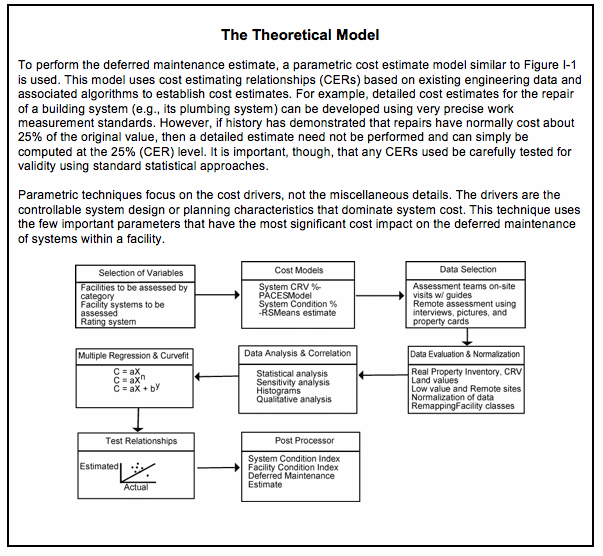
Figure I-1. Theoretical Model for Parametric Estimates
I.1.3 Determine System CRV Percentages
Each system is then assigned representative cost factors based on the estimated percentage of contribution of the major system to the total CRV of the facility within a facility category. For example, in a simple administrative building, the structure may contribute 35% to the CRV, the roof 15%, the exterior 10%, the interior 10% and the mechanical systems 30%--all contributing to equal 100% of the CRV. In complex laboratory and testing facilities, electrical systems make up a larger percentage of the overall building cost, so the breakdown might be structure 25%, roof 15%, exterior 10%, interior 10%, and the mechanical systems 40%. The system's CRV percentages are derived from existing engineering data and adjusted, if necessary, to meet unique facility types.
I.1.4 Condition Assessment Rating Scheme
The NASA condition rating scheme is a simple five-tiered condition code system shown in Table I-1. The DM model breaks a facility down into nine major components. An inspector will rate each of the nine facility components with a condition rating between one to five. The rating is entered into the database and, depending on the asset class of the facility (a launch pad, for example, would have more structural system weighting than a substation), it computes the DM.
Table I-1 Condition Assessment Level
| 5 | Excellent | Only normal schedule maintenance required. |
| 4 | Good | Some minor repairs needed. System normally functions as intended. |
| 3 | Fair | More minor repairs and some infrequent larger repairs required. System occasionally unable to function as intended. |
| 2 | Poor | Significant repairs required. Excessive wear and tear clearly visible. Obsolete. System not fully functional as intended. Repair parts not easily obtainable. Does not meet all codes. |
| 1 | Bad | Major repair or replacement required to restore function. Unsafe to use. |
I.1.5 Determine System Condition CRV Percentage
A significant component of the DM estimate is the application of a system condition CRV percentage based on the assigned condition rating for each system. The system condition CRV percentages, based on existing engineering data, increase as the condition of the system gets lower ratings, creating a larger DM estimate. For example, (using the condition assessments above) if the structure of a facility receives a 5 rating, its contribution to DM is 0% because there is typically no deferred maintenance for this rating. However, if the structure received a 3 rating, its contribution to the deferred maintenance will be 27% of the CRV of the building. The system condition percentages are determined by asset class (section 1.2.1) system. Continuing with the example, in the same building, a 3 rating for the electrical system may contribute 10% of the CRV, while the plumbing system may contribute 27% of the CRV.
I.1.6 Facility Condition Index Calculations
After the condition-rating scheme was established, teams went to the field to assess the facilities using the rating system above. The teams rated each system in each facility and entered that information into a database from which is generated a System Condition Index (SCI) for each system, and a Facility Condition Index (FCI) for each facility, site, and the Agency as a whole. SCI is calculated by first determining the CRV of the system in question by multiplying the facility CRV by the percent system CRV. The value of these system CRVs are then totaled. Next, the system CRV for each facility is normalized or weighted by dividing the system CRV by the sum of all the system CRVs. This quotient is then multiplied by its respective assessment rating. These "weighted" SCIs are then added to determine the facilities SCI. The SCI calculation can be calculated for the site, installation, Center, Mission Directorate, or Agency levels.
The FCI is the CRV normalized sum of the condition ratings for each system within each facility. The building FCI is a simple calculation that weights each of the nine system condition ratings by its associated system CRV percentage per DM category. In each system, the rating is multiplied by its system CRV percentage to get a weighted SCI. The sum of the nine weighted SCIs equals the facility's FCI. Table I-2 is an example. If a facility does not have one of the nine system components, that component is rated zero and will have no weighting, and so does not contribution to FCI and DM.
Table I-2 Facility FCI Example
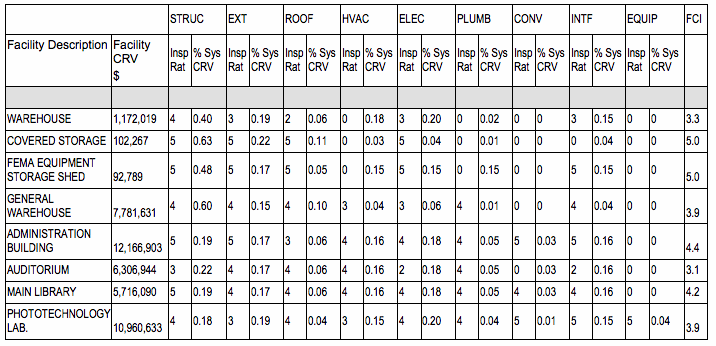
Table I-3 is an example of an FCI for a Center. The Center FCI value is the sum of each facility's CRV-normalized FCI. Each facility CRV is divided by the total Center CRV. That quotient is then multiplied by each facility's FCI producing a CRV-normalized FCI. Weighted FCI = (Facility CRV/ Center CRV) Facility FCI. The sum of these weighted facility FCIs provides a total Center FCI.
Table I-3 Center FCI Example
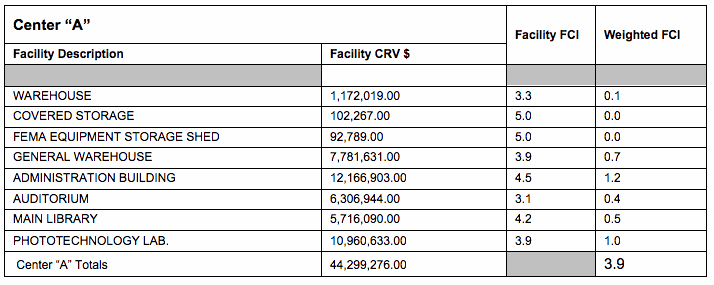
I.1.7 Deferred Maintenance Calculation
The facility DM estimate is determined by adding the DM estimates of the nine facility systems. Table I-4 provides a sample DM estimate for an administrative facility (DM category 5) with a CRV of $10 million.
Table I-4 Sample Deferred Maintenance Calculation
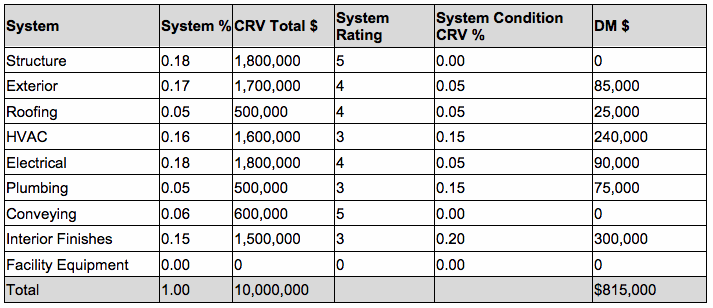
I.2 The Model as Used
I.2.1 Deferred Maintenance Facility Category Codes
Using the NASA real property inventory (RPI), the first step in building the DM database was to map each of the more than 400 NASA facility classes into 42 DM facility categories, as shown in Table I-5. It was necessary to reduce the number of NASA classes to simplify data management. It is important to develop the correct facility category to provide a more complete reflection of the system CRV percentages in the different facility types, ultimately creating a more representative DM estimate. The categories were determined based on facility similarity. For example, DM Category 12, Communication and Tracking Buildings, includes NASA facility classes 131 and 140. Category 13, Communications and Tracking Facilities, includes NASA facility classes 132 and 141. These facilities may include antennas, fueling stations, or other structures that have correspondingly different cost models for purposes of estimating DM from those in Category 12.
Table I-5 Mapping of NASA facility classes into DM Facility Categories
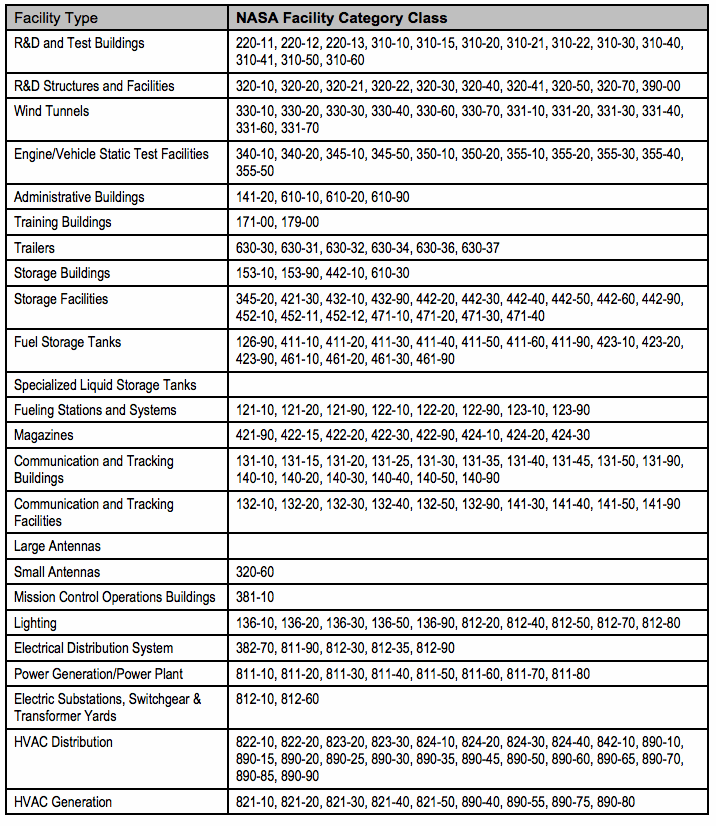
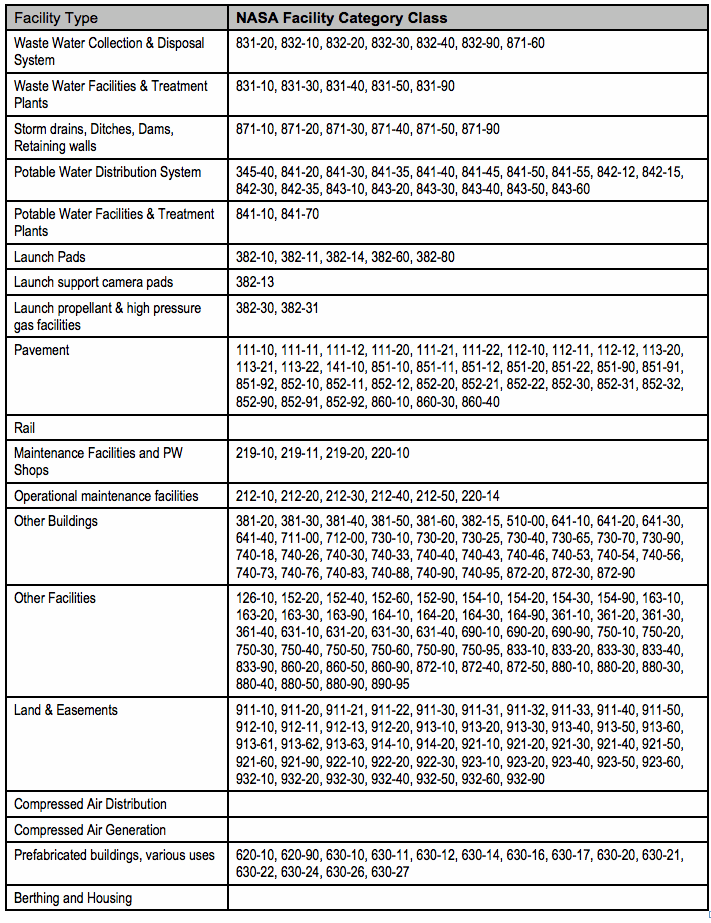
I.2.2 Facility Systems
The DM facility systems were developed from a review of other DM estimating methods for facilities and the ASTM UNIFORMAT II, Classification for Building Elements. The following nine systems were selected for the NASA DM method:
a. Structure: foundations, superstructure, slabs and floors, and pavements that are adjacent to, and considered part of, the facility.
b. Exterior: wall coatings, windows, doors, and exterior sealants.
c. Roofing: roof coverings, openings, gutters, and flashing.
d. HVAC: heating, ventilating, and air-conditioning systems, including controls and balancing devices.
e. Electrical: service and distribution, lighting, communications, security and fire protection wiring, and controls.
f. Plumbing: water, sewer, and fire protection piping, or piping for steam, gas, or water distribution in specialty systems (e.g., tanks, generation plants).
g. Conveying: elevators, escalators, cranes, and other lifts.
h. Interior: all interior finishes including wall coverings, flooring, and ceilings.
i. Program Support Equipment: equipment installed in the facility to provide support for operational testing or research. For example, additional ventilation equipment or separate HVAC systems required only to support special testing or programs.
I.2.3 Current Replacement Value and Facility System CRV Percentages
The NASA RPI system contains the CRV for each facility. Table I-6 shows how the CRV is apportioned between each of the nine facility systems for each of the NASA DM facility categories. The CRV system percentages are derived from the Parametric Cost Estimating System (PACES)3, an accepted estimating tool for Federal construction projects. The PACES method was derived from an evaluation of more than $40 billion of Federal facilities projects.
3 PACES is an integrated, PC-based parametric budgeting and cost estimating system developed by Earth Tech (http://talpart.earthtech.com.) that prepares parametric cost estimates for new facility construction and renovation. It was developed for military facility application and will soon be commercialized for use in the general building, industrial facilities, and transportation industries. PACES is available to military personnel via the U.S. Air Force. A U.S. Government employee can obtain a copy of the current military version of PACES by contacting the Air Force Civil Engineer Support Agency.
Table I-6 DM Categories with CRV Percentage Values
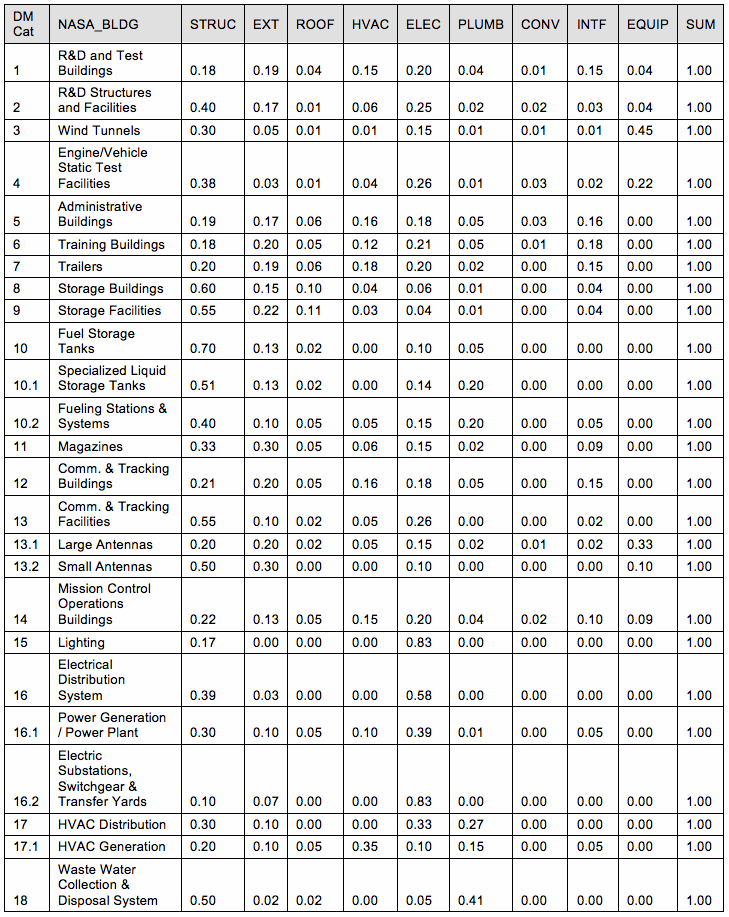
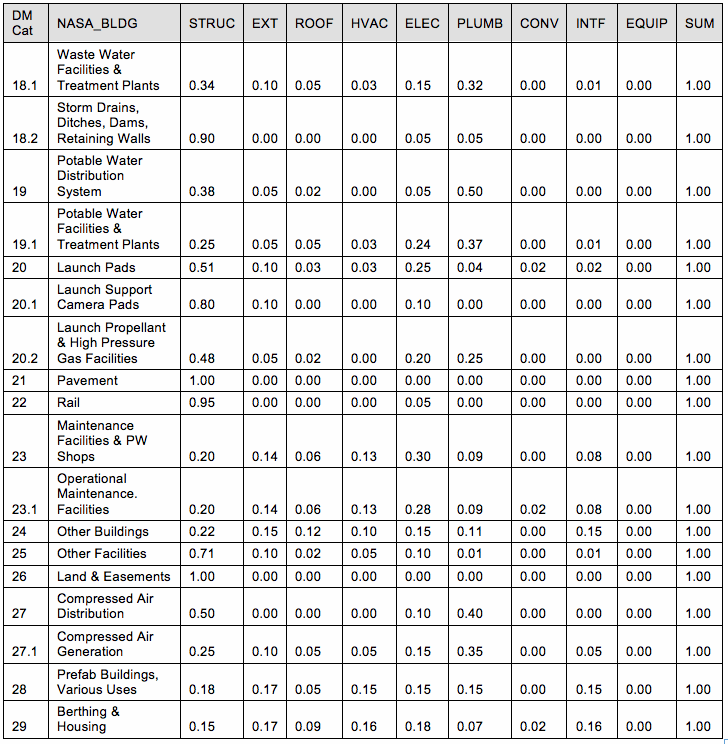
I.2.4 Estimated Repair Cost as a Percentage of CRV by System Condition
Each condition rating has a corresponding system condition CRV percentage. These percentages vary by system type and are provided in Table I-7. This table is crucial to the applicability of the DM method and, as such, was analyzed by several engineering sources. Through the use of a survey of major and minor repairs at KSC, combined with an estimated original construction cost using R.S. Means4 estimating tools, system condition percentages have been developed for each of the nine systems for each of the five ratings. Actual repair costs for a variety of facilities at KSC, such as the Landing Aids Control Building, the cafeteria (Multi-Function Facility), Electromagnetic Lab, Operations Building #1, and Logistics Facility were used to establish the repair costs. The CRVs of these facilities ranged from $602,000 to $22 million.
4 R.S. Means. CostWorks 2003 Version 6.1; 1996-2003. R.S. Means is North America's leading supplier of construction cost information. A product line of Reed Construction Data, R.S. Means provides accurate and up-to-date cost information that helps owners, developers, architects, engineers, contractors, and others to carefully and precisely project and control the cost of both new building construction and renovation projects.
The estimates for the various levels of repair work were compared to an estimated cost for the system construction. These comparisons (expressed as percentages) translate into the DM condition percentages used in the DM model. The process began with the 1 rating, where the cost for a major repair was established. That cost was then compared to the estimated original construction cost, producing a maximum system condition percentage. For example, a 1 rating in structure equates to 150% of the maximum repair cost of the structure of a facility including some demolition and disposal cost. The system condition percentages for 2 through 4 were then established using the same method.
Table I-7 System Condition Percentages
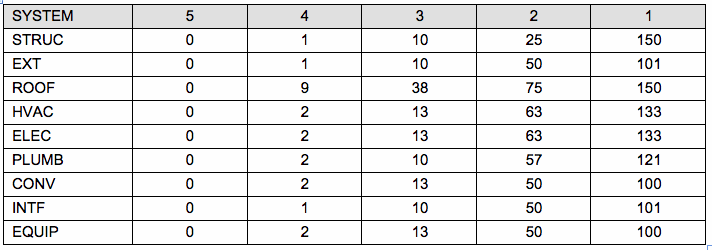
(Percentages greater than 100 account for demolition and disposal costs.)
However, according to the U.S. Army Corps of Engineers (USACE), 50% of the replacement value is the decision point to determine whether a system should be repaired or replaced. Because a 2 rating is where this decision point falls, the USACE standard was applied as a rule, so, 2 ratings were set at a maximum of 50% of the 1 rating system condition percentage. For example, even though the calculated value for a 2 rating for roofing was 90% for KSC, the highest the rating could be is half of the calculated value for the 1 rating (150% in this case), which equals 75%, because that is when the replacement of the roof would most likely occur. The 5 rating was left at 0% because any small DM that would occur in this rating would be negligible.
DISTRIBUTION:
NODIS
This Document is Obsolete and Is No Longer Used.
Check the NODIS Library to access the current version:
http://nodis3.gsfc.nasa.gov
![[NASA Logo]](../Images/nasaball.gif)








